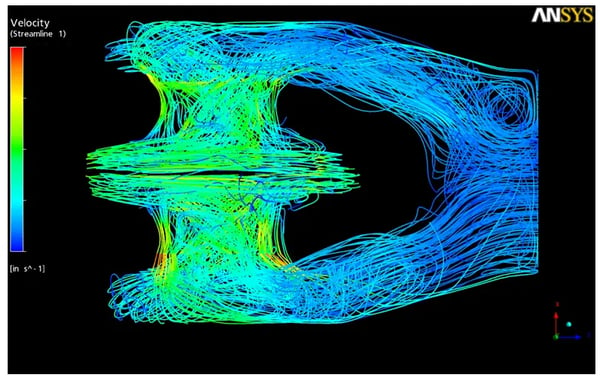CFD Analysis To Resolve Suction Induced Vibration Problems
Mechanical Solutions, Inc. (MSI) was initially contracted to perform specialized testing to quantify the level of flow instability in a Residual Heat Removal (RHR) pump system by the nuclear power plant owner. The task was to perform a CFD analysis of the existing double suction pump inlet, and to make recommendations for improvement with regard to flow-induced vibrations at low volumetric flow rates. The pump operates at 5,500 gpm, far from its best efficiency point (BEP) of 7,700 gpm. The CFD analysis was performed to aid in resolving pump vibrations at the lower flowrate. A solid model of the pump suction, impeller, and pump volute was created in Pro/Engineer. Thereafter the model was meshed & analyzed in ANSYS CFX.
The analyses conducted included a model of suction geometry alone, suction geometry with a low-vane count impeller, and several refinements. The inclusion of the impeller domain unveiled a significant amount of re-circulation in the suction, where none was present when the suction was solved alone. This recirculation occurred at both 5,500 gpm and the BEP. MSI recommended an impeller redesign to resolve this issue.
MSI also explored a possibility of a modest suction geometry redesign due to a noticeable mass flow imbalance between the two impeller inlets noticed by the OEM when the suction domain was solved by itself due to the OEM’s limited computer resources. This imbalance was much smaller when the impeller domain was introduced in MSI’s more comprehensive model, solved on MSI’s 72 parallel processor computer. Therefore, MSI was able to conclude that the suction modification (requiring an expensive new casing) was unnecessary if the pump operation was limited to 5,500 gpm, once it was verified the recommended impeller redesign did not alter the mass flow distribution significantly.
Based on the detailed CFD analysis work, MSI concluded the following:
- The suction geometry had a minor contribution to the unbalanced flow distribution at the double suction inlet. The modest effect it had was due to a difference in area, and spacing relative to the suction centerline, at the inboard versus the outboard impeller boundaries.
- The suction piping did not significantly affect pump behavior.
- MSI discovered that a redesigned suction by itself would not correct instabilities found in the impeller. Any inlet modification contemplated would need evaluation over the flow range of the pump.
- The impeller geometry was key to the performance problems, and in particular the number of vanes was the primary factor in poor performance at off-design flows. Off-design suction re-circulation existed as single phase flow, but its sensitivity to the onset and development of cavitation set the stage for the cavitation surge that had been exhibited during testing.
- MSI recommended an impeller redesign with more vanes which would support stable flow over a wider flow range.
Based on MSI’s recommendation and work results, MSI designed an anti-cavitation surge device to help alleviate the problem on a near-term basis, while a new impeller was designed by the OEM for this difficult service.
REAL-WORLD EXAMPLES AND CASE STUDIES
MSI In Action
Case Study
A Cure for the Common Cold – in Turbines
A steam turbine at a waste-to-energy facility in the Northeast underwent a scheduled repair, at which time the turbine bearings were reworked, after which the turbine periodically experienced very high amplitude shaft vibrations.
Case Study
BFP Fluid Drive Troubleshooting
A boiler feed pump (BFP) driven off of the main steam turbine via a fluid drive was experiencing high vibration levels leading to frequent replacement of the fluid drive bearings.
Case Study
Aeroderivative Gas Turbine Modifications to Solve a Problem
MSI was contracted to understand and help solve a high vibration problem on an aero-derivative gas turbine driven generator.



